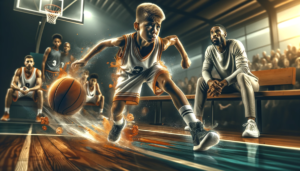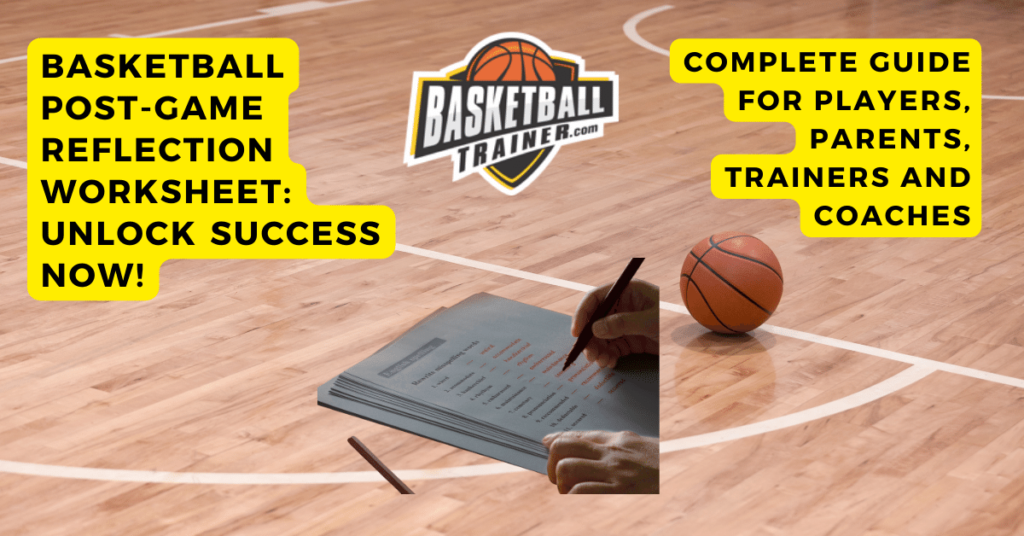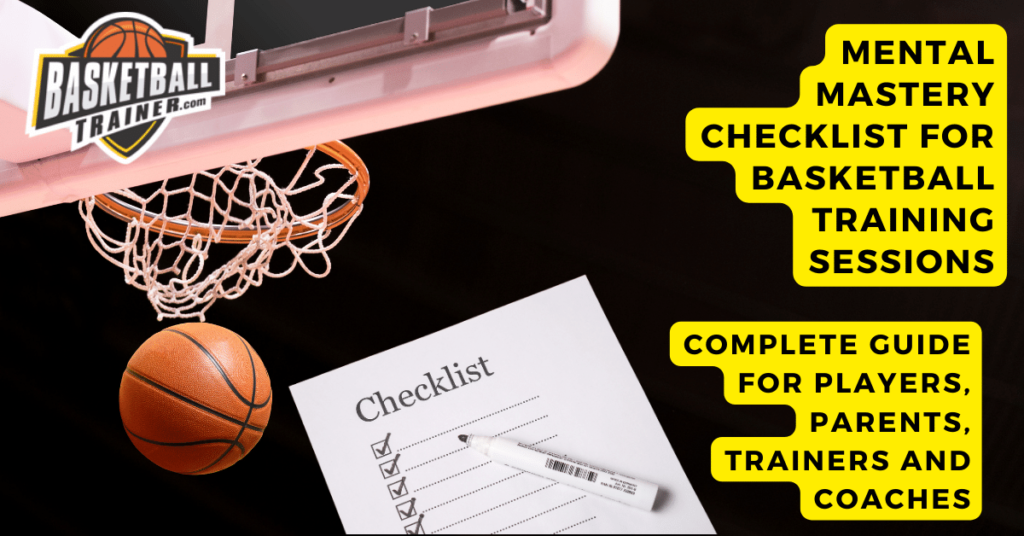
Introduction:
Ever notice how great teachers ask us all the right questions… and if so what are the top questions for parents to ask basketball players? In the vibrant tapestry of a child’s journey through basketball, the role of a parent is not just that of a spectator but a trusted companion and guide. Imagine fostering an environment where support and curiosity intertwine, creating a space for shared moments and genuine connection. As we embark on this exploration, let’s unveil the art of inquisitive parenting—where questions aren’t just queries but pathways to understanding and shared growth.
As a professional basketball trainer of thousands during the last decade, and parent of a college player and Varsity HS parent, as well as witnessing thousands of basketball players… I can tell you I have made many mistakes. Occasionally actually said the right thing at the right time to the right kid. Have had the pleasure of watching several amazing sports parents. And of course a few train wrecks. I have also coached Select / AAU Basketball, and played collegiality myself. Although that should indicate I know the right thing to say at the right time. But what if true learning developed best by questions?
Picture this: your child on the court, eyes ablaze with passion, dribbling through challenges. As a supportive parent, you hold the key to unlocking hidden potentials. The secret? Not manipulation, but genuine curiosity and shared experiences.
Discover the strategic questions that go beyond coaching and competitions, fostering a dialogue that nurtures both the athlete and the relationship. It’s not about steering; it’s about exploring the game together, hand in hand.
Ready to elevate your involvement without manipulation? Embrace the power of thoughtful questions, shaping a basketball journey that’s not just about the game but a shared adventure. Dive in, ask, and watch the magic unfold.
Basketball Goal Setting and Awareness
These adapted questions are designed to encourage self-reflection, goal setting, and awareness of personal and athletic growth in basketball players. They can help players articulate their goals, recognize their strengths and areas for improvement, and develop a deeper understanding of their journey in the sport.
- Desired Outcome Questions for Basketball:
- What are your best hopes from this basketball season?
- What difference would you like today’s training to make for your game?
- How do you think your teammates hope you’ll improve as a result of this practice?
- What do you wish to achieve in your basketball career as a result of basketball training sessions?
- Resource Talk Questions for Basketball:
- What skills do you feel most confident about in basketball?
- How did you become good at those skills?
- What does it take for you to stay sharp and improve in basketball?
- What aspects of your game do you think your teammates or coach appreciate the most?
- Coping with Challenges in Basketball:
- When you face a challenge on the court, how do you deal with it?
- Can you recall a time when a basketball problem you were facing diminished? What role did you play in that?
- Who in your team or family noticed your improvement and how did they react?
- Preferred Future in Basketball:
- Imagine you wake up tomorrow and you’ve achieved your basketball dreams. What’s the first thing you notice about yourself?
- If you could solve any problem you currently face in basketball, what would it be and how would it change your game?
- Scaling Questions for Basketball Progress:
- On a scale of 1 to 10, how close are you to reaching your ideal form in basketball? What makes you say that number?
- What would it look like if you moved one point up on that scale in terms of your skills or teamwork?
- Follow-Up Session Questions for Basketball:
- What’s improved in your game since our last session?
- How did you contribute to this improvement?
- What changes have you noticed in other areas, like teamwork or sportsmanship?
- Exception Seeking Questions for Basketball:
- Can you think of a time when the problem you’re currently experiencing in your game was less problematic? What was different about that time?
- Describe a game or practice session where you felt you performed at your best. What were you doing differently?
- Miracle Questions Adapted for Basketball:
- If a miracle happened and you suddenly became the player you’ve always wanted to be, what would be the first sign that this miracle occurred?
- Imagine if your biggest challenge in basketball was suddenly resolved. How would that change your approach to the game?
- Relationship Questions for Team Dynamics:
- How do you think your improvements in basketball would affect your team?
- What changes in your game would your coach or teammates notice that would make them think you’re playing at your best?
- Identity Questions for Basketball:
- What does being a basketball player mean to you?
- In what ways does basketball help you express who you are?
- Prediction Questions for Future Games:
- If you were to guess, how do you think your next game would go considering the improvements you’re making?
- What do you anticipate being different in your next game based on your current training?
- Reflecting on Past Successes in Basketball:
- Tell me about a past success in basketball. How did you achieve it?
- What strengths did you use to overcome challenges in previous games or seasons?
Basketball Self Reflection and Self Assessment
These questions are designed to stimulate thoughtful reflection and self-assessment, helping players to connect more deeply with their personal basketball journey. They encourage a growth mindset, foster resilience, and promote a deeper understanding of both personal and team dynamics in the sport. Remember, the goal is to guide players to discover their own answers, facilitating growth and development in a supportive and empowering way.
- Solution-Focused Feedback Questions:
- What feedback have you received recently about your basketball skills that you found helpful?
- How have you applied constructive feedback in your practices and games?
- Exploring Player Motivation:
- What motivates you to keep improving in basketball?
- How does your motivation in basketball reflect in your daily practices and game performances?
- Building Confidence in Players:
- What achievements in basketball are you most proud of?
- How do these achievements contribute to your confidence on the court?
- Team Contribution and Collaboration:
- How do you see your role in the team evolving as you improve your skills?
- What contributions do you aspire to make to your team’s success?
- Balancing Challenges and Skills:
- What aspects of basketball do you find most challenging and how do you plan to tackle them?
- How do you balance working on your weaknesses with enhancing your strengths?
- Vision for Personal Growth:
- How do you envision your growth as a player over the next season?
- What personal qualities do you want to develop alongside your basketball skills?
- Reflecting on Resilience and Overcoming Adversity:
- Can you share an experience where you had to overcome a significant challenge in basketball? How did you manage it?
- What lessons did you learn from that experience that you can apply in future games?
- Long-Term Aspirations in Basketball:
- What are your long-term aspirations in basketball?
- How do each of your training sessions bring you closer to these goals?
Self Discovery Questions for Basketball Players
Each of these questions is aimed at guiding players toward self-discovery, fostering a deeper connection with their sport, and encouraging a proactive approach to their development. The goal is to help players not just improve their skills, but also to grow as individuals and team members, ultimately leading to a more fulfilling and successful basketball career.
- Understanding Team Dynamics:
- How do you think your playing style complements your teammates’ strengths and weaknesses?
- What can you learn from your teammates that could enhance your own game?
- Handling Pressure and Stress:
- How do you handle pressure during important games?
- What strategies do you use to stay focused and calm on the court?
- Celebrating Success and Progress:
- How do you celebrate your successes and progress in basketball?
- What does celebrating these achievements teach you about yourself as a player?
- Learning from Setbacks:
- Can you recall a recent setback in your basketball journey? What did you learn from it?
- How have you adjusted your training or mindset as a result of these setbacks?
- Integrating Life and Basketball:
- How does playing basketball influence other areas of your life?
- What life skills have you gained through basketball that help you off the court?
- Feedback for the Coach:
- How can I, as your coach, support you better in achieving your basketball goals?
- What coaching methods or styles do you find most helpful for your development?
- Exploring Game-Time Decisions:
- Think about a recent game. Were there any moments you would have approached differently? Why?
- How do you make decisions during high-pressure moments in a game?
- Reflecting on Personal Values and Basketball:
- How do your personal values align with your approach to basketball?
- In what ways do you demonstrate these values during training and games?
- Building Mental Toughness:
- What does mental toughness mean to you in the context of basketball?
- Can you share an example of when you had to show mental toughness on the court?
- Planning for the Future:
- What are your plans for continuing to develop your basketball skills in the off-season?
- How do you envision preparing for the next phase of your basketball career?
Basketball Introspection and Strategic Thinking Questions for ON and Off The Court Development
 These questions are crafted to guide basketball players in introspection, self-awareness, and strategic thinking, both on and off the court. They aim to foster a holistic approach to player development, emphasizing mental and emotional growth alongside physical and technical skill enhancement. This approach helps in building well-rounded athletes who are not only skilled in the sport but also resilient, self-motivated, and team-oriented. Focus on general curiosity and inquisitiveness rather than teaching.
These questions are crafted to guide basketball players in introspection, self-awareness, and strategic thinking, both on and off the court. They aim to foster a holistic approach to player development, emphasizing mental and emotional growth alongside physical and technical skill enhancement. This approach helps in building well-rounded athletes who are not only skilled in the sport but also resilient, self-motivated, and team-oriented. Focus on general curiosity and inquisitiveness rather than teaching.
- Evaluating Training Effectiveness:
- How effective do you find our current training sessions for your development?
- What changes or additions to our training would you suggest to better meet your goals?
- Discussing Inspirational Figures:
- Which basketball player do you admire most and why?
- What qualities or skills from that player would you like to emulate in your own game?
- Exploring Leadership and Influence:
- In what ways do you see yourself as a leader on the court?
- How do you influence your teammates, both positively and negatively?
- Understanding Emotional Responses:
- How do you manage your emotions during intense or frustrating moments in a game?
- What have you learned about yourself through these emotional responses?
- Discussing Game Strategy:
- How do you prepare mentally for different game strategies?
- What’s your process for adapting to unexpected changes during a game?
- Reflecting on Team Chemistry:
- How do you contribute to building a positive team chemistry?
- What do you think makes a basketball team successful beyond just individual skills?
- Balancing Basketball and Personal Life:
- How do you balance your commitments to basketball with other aspects of your life?
- What challenges do you face in maintaining this balance and how do you manage them?
- Exploring Adaptability and Flexibility:
- Can you give an example of when you had to adapt your play style to suit a game situation?
- How do you stay flexible and open to changes in your role on the team?
- Personal Growth Through Basketball:
- In what ways has playing basketball contributed to your personal growth?
- How do you apply the lessons learned from basketball to other areas of your life?
- Setting and Reviewing Personal Milestones:
- What personal milestones have you set for yourself in basketball?
- How often do you review these goals and track your progress towards them?
Questions on the Journey: Emotional, Personal, Strategic & Team Development
 These questions delve into various aspects of a basketball player’s journey, addressing their personal development, team dynamics, emotional intelligence, and strategic thinking. By engaging players in such reflective and forward-thinking conversations, a coach can help them develop a deeper understanding of their role in the sport, their personal growth, and their contribution to the team. This holistic approach supports the development of not only skilled athletes but also well-rounded, thoughtful, and resilient individuals.
These questions delve into various aspects of a basketball player’s journey, addressing their personal development, team dynamics, emotional intelligence, and strategic thinking. By engaging players in such reflective and forward-thinking conversations, a coach can help them develop a deeper understanding of their role in the sport, their personal growth, and their contribution to the team. This holistic approach supports the development of not only skilled athletes but also well-rounded, thoughtful, and resilient individuals.
- Exploring Resilience in Adverse Situations:
- How do you bounce back after a tough loss or poor performance?
- What strategies or mindsets help you recover and learn from these experiences?
- Understanding the Role of Discipline:
- How do you maintain discipline in your training and game preparations?
- What does discipline mean to you in the context of basketball?
- Reflecting on Coaching Feedback:
- How do you process and implement the feedback you receive from your coach?
- Can you share an instance where coach feedback significantly impacted your game? Positively? Negatively?
- Reflecting on Basketball Parenting Feedback:
- How do you process and implement (if at all) the feedback you receive from us as parents?
- Can you share an instance where parent feedback impacted your game or happiness as relates to basketball?
- Discussing Game Preparation Rituals:
- Do you have any basketball pre-game rituals or routines? How do they help you prepare?
- What goes through your mind during these pre-game moments?
- Evaluating Physical and Mental Fitness:
- How do you assess and maintain your physical fitness for basketball?
- What do you do to ensure your mental health and well-being are in sync with your physical fitness?
- Balancing Individual and Team Goals:
- How do you align your personal basketball goals with the team’s objectives?
- What challenges do you face in balancing these and how do you address them?
- Reflecting on Communication Skills:
- How effective do you think you are in communicating with your teammates and coaches?
- What aspects of your communication do you think you could improve?
- Exploring Game Analysis and Learning:
- How do you analyze your performance after a game?
- What resources or methods do you use to learn and improve from each game?
- Understanding the Impact of Lifestyle Choices:
- How do your lifestyle choices outside of basketball impact your performance?
- What changes have you made or are you considering to support your basketball career?
- Planning for Post-Basketball Life:
- Have you thought about your life after basketball? What plans or aspirations do you have?
- How are you preparing for this transition, both mentally and in terms of skills or education?
Questions on Basketball Performance and Personal Well Being
These questions aim to deepen a player’s understanding of various aspects that influence their performance and well-being, both on and off the court. They encourage players to think critically about their habits, attitudes, and approaches to the sport. By engaging in this reflective practice, players can gain insights into their own behaviors and thought processes, leading to enhanced self-awareness and ultimately, improved performance and personal growth.
- Addressing Stress and Recovery:
- How do you manage stress related to basketball?
- What recovery strategies do you find most effective after intense training or games?
- Exploring the Influence of Role Models:
- Who are your role models in basketball, and what specific qualities do you admire in them?
- How do you try to incorporate these qualities into your own game and life?
- Discussing Teamwork and Cooperation:
- What does effective teamwork look like to you on the basketball court?
- How do you contribute to fostering a cooperative team environment?
- Reflecting on Personal Sacrifices for Basketball:
- What sacrifices have you made for basketball, and how do you feel about them?
- How do these sacrifices reflect your commitment to the sport and your goals?
- Exploring Emotional Intelligence in Sports:
- How do you understand and manage your emotions during competitive situations?
- What role do you think emotional intelligence plays in your performance as a basketball player?
- Balancing Competitive Spirit and Sportsmanship:
- How do you balance being competitive with maintaining good sportsmanship?
- Can you share an instance where you had to navigate this balance?
- Understanding the Role of Nutrition and Health:
- How do you manage your nutrition and health to support your basketball performance?
- What changes have you made in your diet or lifestyle to enhance your athletic abilities?
- Reflecting on Adaptability and Learning:
- How do you adapt to new strategies, coaches, or team dynamics in basketball?
- What have you learned from these experiences of adaptation?
- Discussing Mental Health in Sports:
- How do you prioritize your mental health as a basketball player?
- What support or resources do you find helpful in managing the mental demands of the sport?
- Evaluating Personal Growth and Achievement:
- How do you measure personal growth and achievement in your basketball career?
Questions for Basketball Self Reflection on the Physiological and Psychological Journey
What milestones or achievements are you most proud of, and why? These questions aim to guide basketball players in exploring various dimensions of their athletic journey. They encourage self-reflection, strategic thinking, and personal growth, focusing on both the physical and psychological aspects of being an athlete. This comprehensive approach helps players to develop a nuanced understanding of their strengths, challenges, and goals, fostering an environment of continuous improvement and self-awareness.
- Focusing on Skill Development:
- What specific basketball skills are you currently focused on improving?
- How do you plan and structure your practice sessions to enhance these skills?
- Understanding the Role of Mental Preparation:
- What mental preparation techniques do you use before a game or practice?
- How do these techniques impact your performance and focus?
- Reflecting on Team Dynamics and Personal Role:
- How do you see your role within the team, and how has it evolved?
- What aspects of your role do you find most challenging and rewarding?
- Exploring the Impact of External Factors:
- How do external factors, like family, school, or work, affect your basketball performance?
- How do you manage these influences to maintain focus on your sport?
- Discussing Resilience in the Face of Injury:
- How have you dealt with injuries in your basketball career?
- What lessons have you learned from overcoming these physical challenges?
- Balancing Ambition and Realistic Goals:
- How do you balance your ambitions in basketball with setting realistic and achievable goals?
- What process do you use to set and evaluate these goals?
- Reflecting on the Journey and Progress:
- How do you reflect on your journey in basketball so far?
- What are the key milestones or turning points in your career, and how have they shaped you?
- Understanding the Influence of Parenting Style:
- How does parenting style influence your learning and performance?
- What aspects of my parenting do you find most beneficial or challenging?
- Exploring Peer Relationships in the Sport:
- How do your relationships with teammates and other basketball players influence your game?
- What have you learned from these relationships?
- Discussing Future Aspirations and Pathways:
- What are your aspirations in basketball beyond the current season or phase of your career?
- How are you preparing for these future aspirations, in terms of skills, mindset, and opportunities?
- Evaluating Game Strategy and Tactics:
- How do you evaluate and adapt to different game strategies and tactics during a match?
Questions on Basketball Careers, Learning, Public Relations, Time Managment
What is your process for learning and implementing new plays or tactics in your game?These questions delve deeper into the nuanced aspects of a basketball player’s career, addressing strategic thinking, time management, learning from experiences, physical and mental health, and public relations. This comprehensive approach aids players in understanding the multifaceted nature of being a professional athlete, promoting a well-rounded development that encompasses not only sports performance but also personal and public life management.
- Discussing Time Management and Prioritization:
- How do you manage your time between basketball, other activities, and personal life?
- What challenges do you face in prioritizing basketball, and how do you address them?
- Reflecting on Learning from Mistakes:
- Can you share a recent mistake you made in basketball and what you learned from it?
- How has this learning experience influenced your approach to the game?
- Understanding the Role of Physical Conditioning:
- How do you approach your physical conditioning to support your basketball performance?
- What challenges have you faced in maintaining your physical fitness, and how have you overcome them?
- Exploring the Influence of Fans and Public Perception:
- How does the presence and reaction of fans during a game affect you?
- What role does public perception play in your experience as a basketball player?
- Discussing Stress Management Techniques:
- What stress management techniques do you find effective in dealing with the pressures of basketball?
- How do these techniques help you maintain focus and performance?
- Balancing Technical Skills and Game Intelligence:
- How do you balance developing your technical skills with enhancing your game intelligence?
- What activities or practices do you engage in to improve your understanding of the game?
- Reflecting on the Influence of Family and Friends:
- How has your family and friends’ support influenced your basketball career?
- What role do they play in your ongoing development and success in the sport?
- Understanding the Importance of Rest and Recovery:
- How do you incorporate rest and recovery into your training regime?
- What have you learned about the importance of balancing rest with training?
- Exploring Personal Branding and Image:
- How do you think about and manage your personal brand as a basketball player?
- What steps have you taken to present yourself in a certain way to fans, sponsors, or the media?
- Discussing Adaptation to Different Coaches and Styles:
- How do you adapt to different coaching styles and philosophies?
- What have you learned from working with various coaches throughout your basketball career?
- Reflecting on the Role of Team Culture:
- How does the culture of your team influence your performance and experience in basketball?
- What aspects of your team’s culture do you find most beneficial or challenging?
- Understanding the Impact of In-Game Decisions:
- Can you discuss a critical decision you made in a recent game and its impact?
- How do you prepare yourself to make quick decisions under pressure?
- Exploring the Relationship with Competitors:
- How does your relationship with competitors affect your performance?
- What have you learned from your interactions and experiences with your opponents?
- Discussing the Significance of Role Models and Mentors:
- How have role models or mentors in basketball influenced your approach to the game?
- What specific advice or guidance from them has been most impactful for you?
- Reflecting on Consistency and Routine in Training:
- How important is consistency and routine in your basketball training?
- What routines have you established to ensure consistent progress and performance?
- Understanding the Balance Between Individuality and Team Play:
- How do you balance showcasing your individual skills with playing as part of a team?
- What challenges have you faced in finding this balance, and how have you addressed them?
- Exploring Perspectives on Winning and Losing:
- How do you view winning and losing in the context of your basketball career?
- What lessons have you learned from both wins and losses?
- Discussing the Influence of Media and Publicity:
- How do you handle media attention and publicity in your basketball career?
- What strategies do you use to manage public expectations and your own privacy?
- Reflecting on Personal Sacrifices and Compromises:
- What personal sacrifices or compromises have you made for your basketball career?
- How do you feel about these sacrifices, and how have they shaped your journey?
As we conclude this odyssey into the realm of supportive basketball inquiry, remember, it’s not about having all the answers; it’s about sharing the questions. Be the ally your child needs on and off the court. With genuine curiosity as your guide, you’re not just a parent – you’re a co-pilot in their basketball adventure, making every dribble, pass, and shared smile a cherished note in the symphony of your journey together.

 Types of Images to Include (Court, Training Sessions, etc.)
Types of Images to Include (Court, Training Sessions, etc.) Strategies for Gaining Positive Reviews
Strategies for Gaining Positive Reviews






